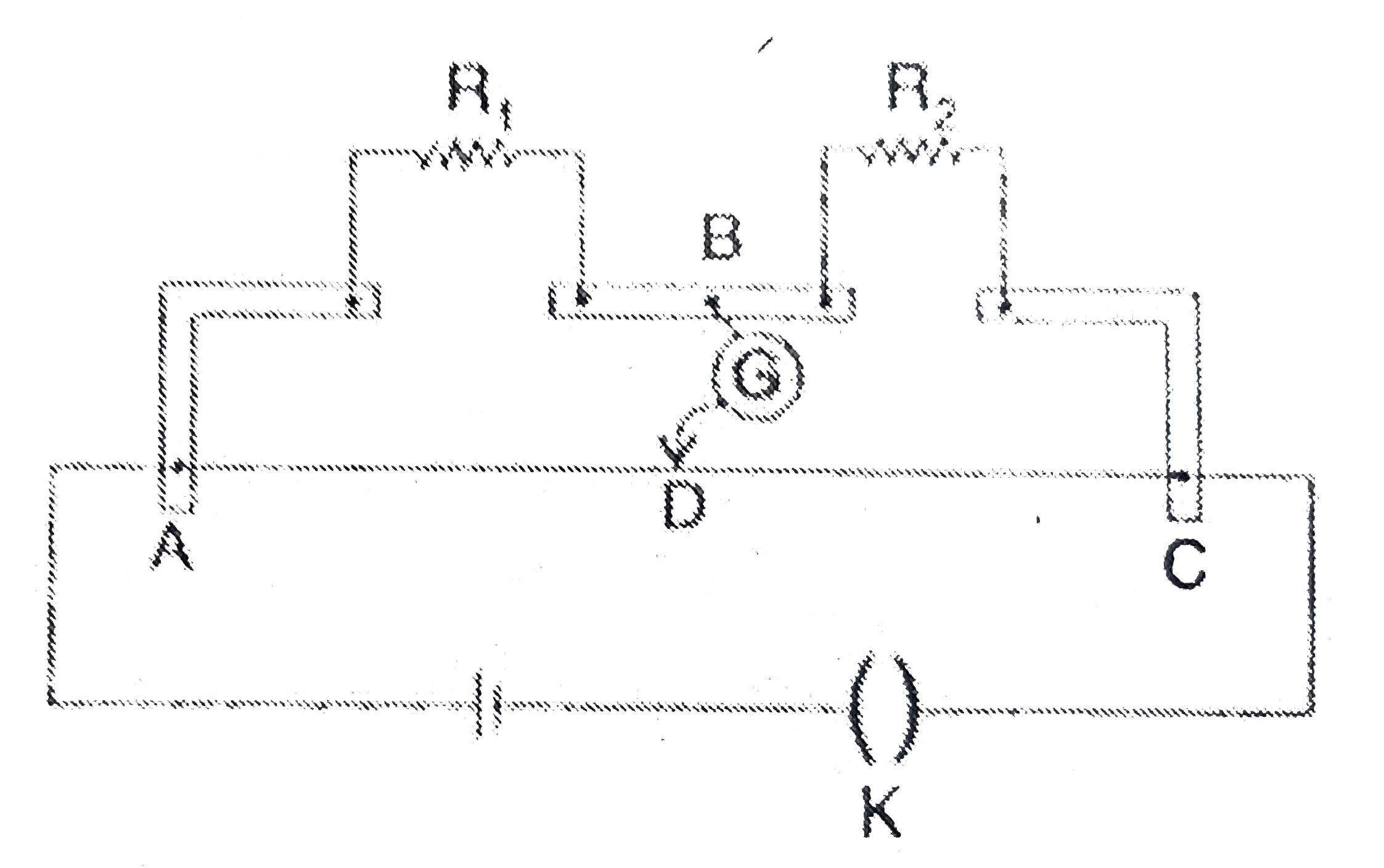State Wheatstone bridge principle and deduce it using Kirchhoff's rules.
Step-by-Step Solution
Step 1: State the Wheatstone Bridge Principle
The Wheatstone Bridge principle states that a Wheatstone bridge is in equilibrium when the ratio of the resistances in one branch is equal to the ratio of the resistances in the other branch. Mathematically, this can be expressed as:
R1R2=R4R3
where R1 and R2 are the resistances in one branch, and R3 and R4 are the resistances in the other branch.
Step 2: Set Up the Circuit
Consider a Wheatstone bridge circuit with resistances R1, R2, R3, and R4 connected to a battery of emf E. A galvanometer with resistance r is connected between the junctions of R1 and R2 and the junctions of R3 and R4.
Step 3: Apply Kirchhoff’s Laws
To analyze the circuit, we will apply Kirchhoff's Voltage Law (KVL). Assume the current entering the circuit is I, which splits into two branches: I1 through R1 and R2 and I2 through R3 and R4.
Step 4: Write KVL for the Loops
1. For the loop containing R1 and R2:
I1R1+I2R2−E=0
Rearranging gives:
I1R1+I2R2=E(1)
2. For the loop containing R3 and R4:
I2R3+I1R4=0
Rearranging gives:
I2R3+I1R4=0(2)
Step 5: Set the Condition for No Current in the Galvanometer
For the bridge to be balanced, the current through the galvanometer must be zero. This means:
I1R2=I2R3(3)
Step 6: Substitute and Solve
From equation (3), we can express I2 in terms of I1:
I2=I1R2R3
Substituting this into equation (1):
I1R1+(I1R2R3)R2=E
Factoring out I1:
I1(R1+R22R3)=E
Step 7: Derive the Ratio of Resistances
Now, using the condition for balance (when I=0):
R1R2=R4R3
This confirms the Wheatstone bridge principle.
The Wheatstone Bridge principle states that a Wheatstone bridge is in equilibrium when the ratio of the resistances in one branch is equal to the ratio of the resistances in the other branch. Mathematically, this can be expressed as:
R1R2=R4R3
where R1 and R2 are the resistances in one branch, and R3 and R4 are the resistances in the other branch.
Consider a Wheatstone bridge circuit with resistances R1, R2, R3, and R4 connected to a battery of emf E. A galvanometer with resistance r is connected between the junctions of R1 and R2 and the junctions of R3 and R4.
To analyze the circuit, we will apply Kirchhoff's Voltage Law (KVL). Assume the current entering the circuit is I, which splits into two branches: I1 through R1 and R2 and I2 through R3 and R4.
1. For the loop containing R1 and R2:
I1R1+I2R2−E=0
Rearranging gives:
I1R1+I2R2=E(1)
I2R3+I1R4=0
Rearranging gives:
I2R3+I1R4=0(2)
For the bridge to be balanced, the current through the galvanometer must be zero. This means:
I1R2=I2R3(3)
From equation (3), we can express I2 in terms of I1:
I2=I1R2R3
Substituting this into equation (1):
I1R1+(I1R2R3)R2=E
Factoring out I1:
I1(R1+R22R3)=E
Now, using the condition for balance (when I=0):
R1R2=R4R3
This confirms the Wheatstone bridge principle.
Topper's Solved these Questions
- CURRENT ELECTRICITYBOOK - PRADEEPCHAPTER - CURRENT ELECTRICITYEXERCISE - Conceptual Problems
3 Videos
- CURRENT ELECTRICITYBOOK - PRADEEPCHAPTER - CURRENT ELECTRICITYEXERCISE - Very short Q/A
7 Videos
- COMMUNICATION SYSTEMSBOOK - PRADEEPCHAPTER - COMMUNICATION SYSTEMSEXERCISE - MODEL TEST PAPER-2
9 Videos
- DUAL NATURE OF RADIATION AND MATTERBOOK - PRADEEPCHAPTER - DUAL NATURE OF RADIATION AND MATTEREXERCISE - Exercise
191 Videos
Similar Questions
Knowledge Check
Wheatstone bridge can be used
Ato compare two unknown resistances.Bto measure small strains produced in hardmetalCas the working principle of meterbridgeDall the above
Balanced Wheatstone Bridge
View SolutionExtended Wheatstone Bridge
View SolutionWhat is Kirchhoff's loop rule ?
View SolutionState the two Kirchhoff's laws.
View SolutionQuestions|Wheatstone Bridge
View Solution(a) State Kirchhoff's rules for an electirc network. Using Kirchhoff's rules, obtain the balance condition in terms of the resistances of four arms of Wheatstone bridge.
(b) In the meter bridge experimental set up, shown in the figure, the null point 'D' is obtained at a distance of 40 cm from end A of the meter bridge wire. If a resistance of 10Ω is connected in series with R1, null point is obtained at AD=60cm. Calculate the values of R1andR2.

View SolutionWheatstone Bridge and Symmetry Circuit
View Solution
